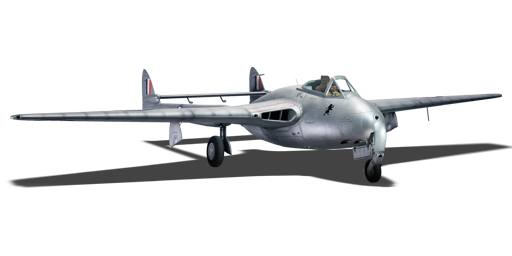



The de Havilland Vampire began in 1941 as a very experimental aircraft, designed around de Havilland's newly developed turbojet engine, the Halford H.1 (later renamed the de Havilland Goblin). It emerged just as turbojets were becoming powerful enough to power single-engined aircraft, aided by the Vampire's unusual twin-boom design, which allowed a shorter tail pipe to be fitted and thus reduced power loss from the engine. The prototype first flew in September 1943, only 6 months after the Gloster Meteor, and production began in May 1944, although the first units would not enter service until 1946. The Vampire FB.5 was introduced in 1948, featuring armour around the engine, clipped wings, and hardpoints for bombs and rockets, allowing it to undertake the fighter-bomber role. It was the most produced variant of the Vampire, with over 1,000 units built.
Introduced in Update 1.33, the Vampire is a highly manoeuvrable but relatively slow jet, making it rather similar in style to the numerous Spitfires found earlier in the tree. While it is unlikely to outaccelerate or outrun any of its opponents, even in a dive, the excellent manoeuvrability can allow the Vampire to dodge and entrap opponents into a turnfight which it will inevitably win. Once in position, the nimble but stable platform and four powerful Hispano cannons make taking shots relatively simple. However, as with all jets, particular attention must be paid to ensure that the Vampire is not left low on energy and vulnerable to encroaching enemies once a turnfight is committed to.
flaps
flaps
flaps
brake
| Belt | Belt filling | Armor penetration (mm) at a distance: | |||||
|---|---|---|---|---|---|---|---|
| 10 m | 100 m | 500 m | 1000 m | 1500 m | 2000 m | ||
| HEI/SAP-I/T | 21 | 19 | 14 | 9 | 5 | 4 | |
| AP-T/HEI/SAP-I | 36 | 33 | 24 | 15 | 10 | 7 | |
| SAP-I/HEI/AP-T/HEI/SAP-I | 36 | 33 | 24 | 15 | 10 | 7 | |
| AP-T/HEI/T | 36 | 33 | 24 | 15 | 10 | 7 | |
| AP-T/SAP-I/HEI/AP-T | 36 | 33 | 24 | 15 | 10 | 7 | |
| HEI/SAP-I | 22 | 20 | 14 | 9 | 6 | 4 | |
4 × RP-3 rockets
4 × RP-3 rockets
4 × RP-3 rockets
4 × RP-3 rockets
4 × RP-3 rockets












Flight performance | |
|---|---|
Survivability |
|---|
Weaponry | |
|---|---|